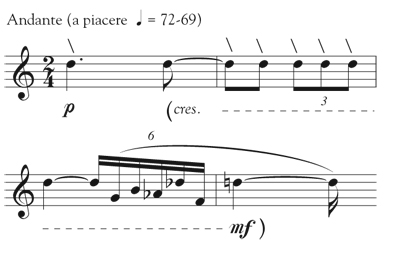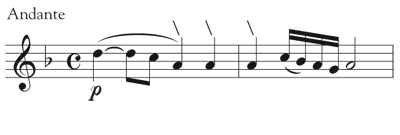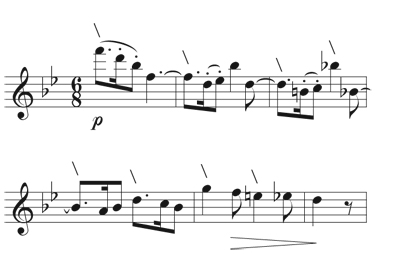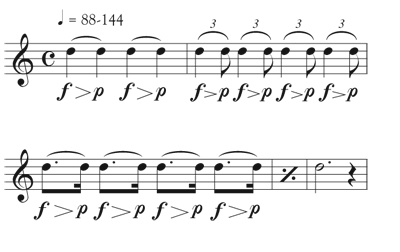I am not that much into singing, but I have always been a serious hummer, especially of Mozart. Some years ago, while humming the opening phrase of the G Major Flute Concerto, I suddenly realized that I wasn’t humming it this way: Doo-doo-to-doo-doo-De-ya-dooooo, but actually like this: Dum-dum-ta-dum-dum-De-ya-duuuum. I became aware of the subtle lip and chin motions that were deftly shaping all my um endings. It was a dumbfounding moment of recognition of a bell-tone style of articulation very similar to what I had been doing on the flute for a long time, especially in maestoso-type music, but I had never really given it any serious thought.
So I fetched my flute and played the opening Mozart phrase while scrutinizing my facial profile in a three-way magnifying mirror to confirm my assumption. Sure enough, those extremely small piscine-looking um motions were evident on every note ending. (Mirror, mirror, on the wall, you are sometimes the best teacher of all.)
However, in my flute version of that opening Mozart phrase, those um chin-up motions stopped short of actually closing my lips to pronounce the m of um. In fact, what they were really doing was tantamount to the subtle kinds of embouchure changes I always make to prevent the pitch from going flat in diminuendos, except that for these individual diminuendos I was executing the changes very quickly and unobtrusively – but without closing my lips at the end of each note.
What might be the advantage in using this tapering technique? Actually, there are at least two benefits, both of which enhance the musicality of one’s phrasing. First, for tenuto repeated notes like the middle Ds of the Mozart phrase, I do not need to tongue so hard to ensure articulation clarity. The quick tapers at the ends of the quarter notes (I call them nuance tapers)1 automatically provide an ideal foundation for clearer enunciation without having to separate the notes – a big advantage in a highly reverberant concert hall.
Second, on almost all instruments, dynamic changes on any given note typically alter the relative strength of the overtones of that note, thus changing its timbre. A louder tone has more and stronger overtones, a softer tone fewer and weaker overtones. On the piano, no matter how hard a key is struck, the tone diminishes and changes timbre automatically. On a woodwind, brass or string instrument, however, the dynamic level and resultant timbre of a tone can be manipulated by the player at any time during its duration. Thus, a judiciously applied nuance taper at the end of a note becomes another valuable tool for timbre variation. Of course, the built-in dynamic and pitch variables when using vibrato also have a salutary effect on timbre. So the next time you receive a compliment about the amazing “palette of colours” in your tone, you can reply modestly, “Thanks, I’m so glad you liked my varying dynamics and nuance tapers.”

Here’s how I notate the nuance tapers for the opening of the Mozart Concerto in G Major. The slashes over the notes indicate the nuance tapers.
Nuance tapers can be used in many types of phrases, but they are especially effective on repeated notes, as in the above Mozart phrase. Even though the flute never actually gets to play it, the first theme of the Mozart D Major Concerto also offers a similar opportunity for nuance tapers by the violins.

The opening two bars of the Jacques Ibert Pièce, with their built-in accelerated rhythms, offer an ideal canvas onto which one can apply a series of nuance tapers superimposed on an overall crescendo. Too often this phrase is played in an overly smooth, bland, unrhythmic style. However, Ibert’s a piacere marking is assuredly an invitation for applying phrase-shaping dynamics and a tasteful rubato even though his only explicit markings in the introduction are a piano at the very beginning and a crescendo in bars 5-6.

In the flute solo of Maurice Ravel’s Daphnis et Chloé bars 4 and 5 after rehearsal number 177 contain a series of repeated B naturals notated in gradually accelerating rhythms. Nuance tapers can be applied on each of the syncopated Bs, triplet Bs, and, with enough practice, on the four 32nd note Bs. It is also vitally important to observe the printed crescendo in the fifth bar of 177 and not wait until the ascending scale on the fourth beat, as is often done. Incidentally, though the printed crescendo in the flute part begins on the second beat, the accompanying crescendo for the second violins, violas, cellos, basses and fourth horn actually begins on their first beat. Therefore, the flute, surely in self-defense, should begin its crescendo on the first beat as well.
Ravel, Daphnis et Chloé, Suite 2

Simpler, though significant, examples of nuance tapers also occur throughout the literature.
Bizet, L’Arlésienne, Suite No. 2, Menuet

Chaminade, Concertino, Op. 107

Griffes, Poem

Ravel, Boléro

Nielsen, Concerto for Flute and Orchestra

Schubert, Introduction and Variations on “Trockne Blumen”

Ganne, Andante et Scherzo

Bach, Sonata No. 1 in B Minor, BWV 1030

Brahms, Variations on a Theme by Haydn

Since nuance tapers are simply shorter versions of longer diminuendos, the embouchure changes involved in controlling pitch and tone quality are exactly the same. It is just a question of adjusting to the faster timing. The following exercise is designed to help you perfect that timing and the fine coordination that goes with it. The first note of each pair represents the louder tone, and the second tie-over note represents the diminishing tone. For the louder tone be aware of a very subtle pulling down of the upper lip directing the air lower (to avoid sharpness), and for the diminishing tone a tiny upward (but not forward) movement of the chin directing the air higher.2 Be sure to have a tuner handy so that you can monitor the pitch accuracy of the diminishing tone which of course has a tendency to go flat. Keep in mind that for a musically effective nuance taper, it is not necessary to diminish all the way down to a super pianissimo. The ear can easily detect and appreciate even the slightest taper. Careful listening to both your live and recorded sound will lead to the best artistic choices.

In this exercise practice the dynamic patterns of the note pairs at a moderate tempo, starting at MM=88 per beat and gradually increasing the tempo until quarter=144. Apply those dynamic patterns to different notes in the form of scales and intervals traversing the flute’s entire three-octave range. Also practice different dynamic gradations like f-mf, mf-p, mp-pp and more subtle ones like mf-mp, mp-p and p-pp.
A welcome bonus in managing quick and well-controlled nuance tapers is that you will be able to do genuine fp’s more confidently (fp’s are, in fact, instantaneous versions of nuance tapers). Brass and string players have a natural bent for playing effective fp’s. There is no reason why flutists cannot do this as well. For instance, go to the first movement of the Mozart D Major Flute Concerto and test yourself on the eleven fp’s contained therein. They are Mozart’s authentic dynamic markings, but too many flutists blithely ignore them, perhaps out of fear of going flat. That fear can be eliminated once you establish a solid technique for nuance tapers. (Some editions of the Mozart D Major may not include all of the fp’s, so here is a checklist for the first movement: bar 72, beat 2; bar 80, beat 1; bar 82, beat 1; bar 88, beat 2; bar 90, beat3; bar 91, beat 3; bar 155, beat 1; bar 157, beat 1; bar 165, beat 2; bar 167, beat 3; bar 168, beat 3.)
Speaking of brass players and their enviable skill in making quick dynamic changes, I have often wondered why some trumpeters, when performing the opening solo in the first Promenade of the Mussorgsky-Ravel Pictures at an Exhibition, prefer to play the quarter notes in an overly legato style instead of applying a subtle nuance taper on each one. Besides being more stylish, it would also be paying homage to Mussorgsky’s original version for piano, where each quarter note undergoes an automatic and natural nuance taper.
I began this article by mentioning my predilection for humming. Did you know that humming can also be an important part of a singer’s warm-up, akin to a brass player’s mouthpiece buzzing? Not only that, but some voice teachers apparently prescribe humming as a therapy for vocal problems. If you Google “humming and singing”, you will be surprised at how many vocal technique references pop up (about 848,000). For instance, try the Singing Exercises for Dummies Cheat Sheet: A “Hum”-able Vocal Warm-Up. There is even some welcome advice from Human Resources concerning “what to do about co-workers who hum all day long”.
Endnotes
1Arthur Weisberg in The Art of Wind Playing (Schirmer Books), calls them “resonance tones” (pp. 33-43), and Peter-Lukas Graf in his richly-detailed treatise, Interpretation: How to Shape a Melodic Line (Schott) calls them “flexible phrasings” (p. 55).
Perhaps one could combine those two terms plus my “nuance taper,” into one all-purpose acronym, RFNTP (Resonant and Flexible Nuance Taper Phrasings).
2See my article, “Jawboning and the Flute Embouchure,” The Instrumentalist (Sept., Oct., Dec. 1971) and reprinted in Flute Talk (May/June, Sept., Oct. 1987)






